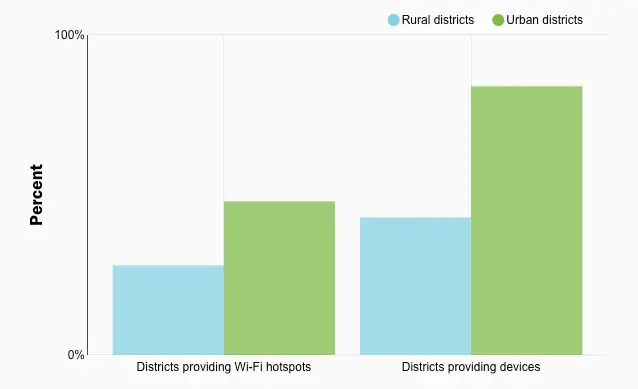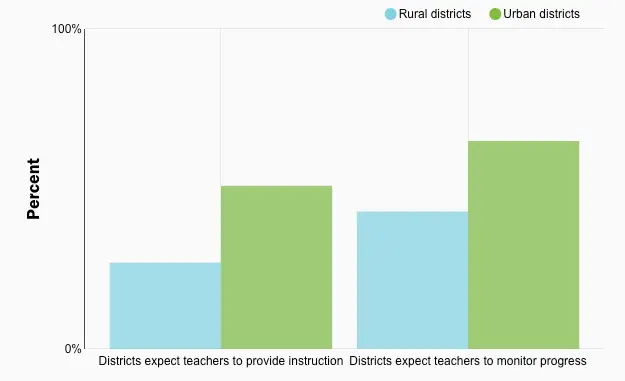While COVID-19-related school closures in spring 2020 challenged every school district, students in rural districts faced especially significant barriers. In particular, lack of consistent internet limited their access to online instruction.
These gaps in access to the internet and instruction were evident in our research. However, we also found that rural districts devised innovative strategies to help put materials and instruction in the hands of students.
The start of the next school year is approaching quickly, and many districts plan to start remotely. Ensuring every student has the internet connectivity to access instruction will require structural change that school districts cannot easily deliver on their own. But in the absence of action at the state or federal level, rural districts may need to get creative.
In this post, we describe the key findings from our work with rural districts during the pandemic. We devote particular attention to strategies used by rural districts across the country in hopes they might be of use to other district leaders.
Rural districts face hurdles in providing remote instruction.
Internet access was a challenge for all school districts during spring 2020 school closures. But solutions that worked in urban and suburban districts, such as distributing hotspots, don’t always work in rural areas, where there may not be infrastructure to support high-speed internet. Results from the Center on Reinventing Public Education’s (CRPE) study of remote learning in 477 school systems across the country found that rural districts were much less likely than urban districts to provide students with Wi-Fi hotspots or devices (e.g., laptops/tablets). The lower rates of internet and device distribution in rural areas cannot be explained by rural students’ having less of a need for hotspots or devices than urban students. Prior to the coronavirus outbreak, the percentage of students 5 to 17 years old without any access to the internet at home was about the same in rural and urban areas—about 13%.
Figure 1. Rural districts provided less access to Wi-Fi and devices
These gaps in student access likely contributed to the differences in districts’ instructional expectations of teachers between rural and urban districts, as shown in the chart below.
Figure 2. Fewer rural districts expected teachers to provide instruction and monitor student progress
Because the analysis was based on publicly available information on school websites and social media platforms, these data may understate rural districts’ expectations for instruction, as well as access to hotspots and devices. In a forthcoming study, researchers from the National Center for Rural Education Research Networks (NCRERN) compared data from district websites to interviews with rural district leaders on their districts’ responses to school closures and found that the information presented online represented only a small portion of the efforts in practice.
Despite this caveat, findings of a recent study by NCRERN echo CRPE’s national data on internet connectivity challenges. Through interviews with administrators and leaders in 40 rural school districts in Ohio and New York, NCRERN found that, while districts were generally able to arrange access to devices for their students, internet access was almost always a challenge. In some districts, over 30% of students had no internet access at home.
Rural districts found creative solutions to help students access learning.
Despite significant obstacles to providing infrastructure for remote instruction, some rural school districts in the NCRERN study took creative actions to help families connect to remote learning (beyond lessons and homework in the form of paper packets). These included:
- mapping locations in the local community that offer free internet access
- purchasing cellular data for students who have phones or tablets
- connecting families with companies that offer free or low-cost internet, and
- setting up hotspots and outdoor work areas on school grounds so students could download materials and upload assignments.
While these solutions generally precluded delivery of real-time, live instruction for all students, they made it possible for students to access some type of instruction from their teachers.
Recognizing that traveling to community-based internet hubs can be a hurdle for families, some school districts found other ways to deliver lessons.
One Ohio district asked teachers to prerecord lessons, upload the videos on USB drives, and deliver them to students’ homes for students to watch and supplement their assignments. Another district reported that several families did not want to have internet in their home. In these cases, teachers were expected to call students and provide instruction and check in on their progress over the phone.
While there are benefits to live teaching—especially peer-to-peer contact—research shows that, when done well, other remote learning approaches can also help students learn.
Rural districts need support to meet each student’s needs.
Looking ahead to the fall, the challenge of connectivity and remote learning isn’t going away, especially as the virus spikes again across much of the country and with many districts announcing a remote start to the school year. State and federal governments must act forcefully—and immediately—to ensure that rural students are not left behind in accessing what is now essential infrastructure. As others have pointed out, learning in parking lots isn’t a long-term solution, and school districts need help to solve this problem.
Unfortunately, an early look at state guidance to school districts indicates that few state education agencies are meaningfully supporting school districts’ efforts to acquire devices and hotspots, let alone pushing state and local policymakers to fill the rural infrastructure gaps. Several states, such as Arkansas, Ohio and Texas, have announced that they are using funding from the CARES Act to provide devices, hotspots, and home routers. This is an important step, and future federal relief bills should allow districts to direct money toward purchasing hotspots, devices, and other items needed to support remote education. Both states and the federal government must also establish improving rural broadband infrastructure as priority—otherwise many rural students will still be left behind.
The practices we identified in rural school districts demonstrate that, in the absence of a vaccine and universal internet connections, districts can take action to make sure that their students can access instruction from their teachers—with some creativity and flexibility.
As one rural district leader from New York state told researchers, it’s clear that one-size-fits-all solutions don’t work for students in the COVID-19 crisis. As families continue to grapple with the pandemic, rural school district leaders must help schools and teachers use every tool to find solutions that work for each family. While state and federal policymakers work on the infrastructure solutions, rural students can’t wait.
This post originally appeared in Brookings.






